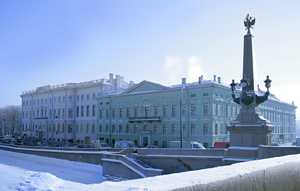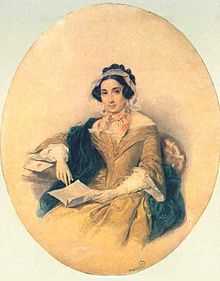Ficquelmont Palace
Coordinates: 59°56′46″N 30°19′50″E / 59.946189°N 30.330473°E

The Ficquelmont Palace (Russian: дворе́ц Фикельмона, Ficquelmont dvorets) is a neoclassical palace in Saint Petersburg, Russia. The Palace was the Russian home of the Franco-Austrian counts de Ficquelmont.

Architecture
The Ficquelmont Palace is set in central St-Petersburg, it lies on Suvorova Square by Trinity Bridge between the banks of the Neva and the Field of Mars. Its official address is Palace Embankment 4. The Palace fronts Palace Embankment and backs Millionnaya Street ; water frontage on the Neva was extremely prized by the Russian aristocracy while Millionnaya Street was considered one of tsarist Russia's grandest address.
The Palace façade is one of the finest example of Russian neoclassical architecture. The neoclassicisism, imported by foreign architects, especially during the reign of Empress Catherine II, had become very fashionable within Russian nobility by the mid-18th century when the palace was built.
The palace façade is shaped with great simplicity, combining harmonic proportions and a moderate ornamentation that highlight few decorative elements, such as the piano nobile balcony facing the Neva and the Palace's pediments.
The Ficquelmonts


The Palace was bought in 1829 by count Charles-Louis de Ficquelmont who had just been appointed Ambassador Extraordinary to Russia. Ficquelmont made it his family's St. Petersburg residence as well as the Austrian Embassy.
Ficquelmont was the son of a prominent high nobility Lorrainer family (House of Ficquelmont).[1] Born in pre-Revolutionary France, he was introduced to the King at the Royal Court of Versailles in 1789. After his family was forced into emigration, he eventually entered the Austrian imperial army in 1793 where he quickly rose to the rank of a Generalmajor and received the capitulation of Lyon in 1814.[2] After the fall of Napoleon, Ficquelmont became one of the Austria's foremost diplomat and statesman.[3] He was made Field marshal of the Austrian Imperial army and succeeded Prince Metternich as Minister-President of the Austrian Empire and Foreign Minister of the Austrian Empire.
Ficquelmont had married into the highest Russian nobility. His wife, countess Dolly de Ficquelmont was the granddaughter of Prince Mikhail Kutuzov. She was born countess Daria Fyodorovna von Tiesenhaussen, the daughter of German Baltic count Ferdinand von Tiesenhausen, aide-de-camp of Emperor Alexandre I of Russia[4] and Russian Princess Elisabeth Mikhailevna Koutouzova. Dolly's sister was countess Catherine von Tiesenhausen, a lady-in-waiting to the Empress and an influential member of the Imperial Court of Russia.
The Ficquelmonts had long been friends of the Russian Imperial family. In 1823, during a visit to St-Petersburg, Emperor Alexander of Russia and Empress Elizabeth Alexeievna had befriended[5] the young couple who were often seen at Court. Soon after their visit, Emperor Alexandre granted Dolly's mother an imperial pension and, when the Ficquelmont had their only daughter in 1825, the Imperial couple were made godparents.
Life at Ficquelmont Palace
Due to their close ties with the Imperial family as well as their wealth and vast culture, the Ficquelmonts became one of Russia's most influential family, both politically and socially.

Politically, Ficquelmont quickly became extremely influential on the politics of Emperor Nicholas I. He was instrumental in strengthening the Holy Alliance and aligning Russian foreign policy with the Metternich counter-revolutionary system. During his embassy, Nicholas I was pushed into acting more and more as the protector of ruling legitimism and as guardian against revolutions, a path the tsar was only too happy to follow as it mirrored his own views. Ficquelmont was also a known russophile and he strongly advocated for a tighter alliance between the Austrian and Russian Empires. Ficquelmont's influence in Russian foreign policy was long-lasting and his palace was a usual meeting place for Russia's top statesmen and an invitation was highly sought after by aspirant politician. As a sign of his appreciation for Ficquelmont's work, Emperor Nicholas I awarded him the Orders of St. Andrew, St. Alexander Nevsky, St. Vladimir and St. Anna.
Socially, the Ficquelmonts were a cornestone of St. Petersburg's high society. Aristocrats renown for their culture and wit, the quality of their taste and cuisine as well as for their exclusive gatherings, their ball and parties were so very fashionable amongst Russian high nobility. Dolly, who took a great interest in literature, philosophy, religion and politics, also held a salon that had been regarded as one of the most influential of the time. The palace, where Pushkin, Alexander Turgenev, Prince Viazemski and Ivan Kozlov were regulars, had been described as a "place of wisdom and intelligence" and as "(...) the setting the two most illustrious salon of the period (1830s), reigned over by Ficquelmont's wife, grand-daughter of Prince Kutuzov".[6]
Literature
Pushkin was often a guest of the Ficquelmonts, close to Dolly's mother, he also befriended the couple.
In 1922 historian Mstislav Tsiavlovski published the writings of poet Nachtchokine:[7] according to Barteniev, Pushkin was in love with a brilliant socialite noblewoman holding a salon in Saint Petersburg. Even if the lady is not named, no doubt she is countess de Ficquelmont. However, historian Leonid Grossman has said Pushkin only saw himself as a new Boccaccio and that he and countess de Ficquelmont were only just friends. Indeed, the relationship between the Ficquelmonts was perfect.
Ficquelmont's palace is strongly believed to be the frame for the old countess' palace in Pushkin's story The Queen of Spades. Pushkin would also have depicted his own feelings for Dolly through Hermann's love for Lise.
Sources
- Фикельмон, Дарья Федоровна
- М. И. Гиллельсон. Пушкин в итальянском издании дневника Д. Ф. Фикельмон
- Akten zur Geschichte des Krimkriegs: Österreichische Akten zur Geschichte
References
- ↑ The House of Ficquelmont "belongs to the very ancient Chivalry of Lorraine, [where] it has long been one of the most prominent noble family due to its antiquity and alliances" Famille de Ficquelmont in l'Intermédiaire des chercheurs et des curieux, Volume 47, p.810, Paris, 1903
- ↑ in Baptiste-Honore-Raymond, Les diplomates et hommes d'état européens, 3e série, Bruxelles, 1847
- ↑ Karl Ludwig Graf von Ficquelmont. In: Rudolf Flotzinger (Hrsg.): Oesterreichisches Musiklexikon. Verlag der Österreichischen Akademie der Wissenschaften, Wien 2002, (Band 1), S. 443.
- ↑ Ferdinand died at Austerlitz, inspiring the André Bolkonski episode in Tolstoï's War and Peace
- ↑ The large correspondence between the Khitrovos (Dolly's mother) and the Emperor shows the Emperor's strong feelings for the Ficquelmonts
- ↑ in Personality and Place in Russian Culture, Essays in Memory of Lindsey Hughes, Simon Dixon, 2010, History
- ↑ Pushkin's friend